Nidularium Leprosa
Click thumbnails for full size, scaled to a new window.
Nidularium Leprosa
cv. of rutilans X rosulatum ??
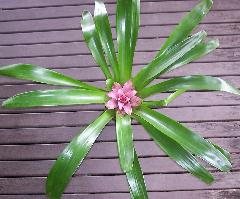
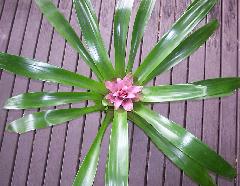
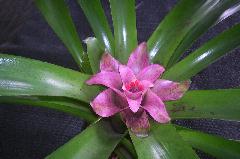
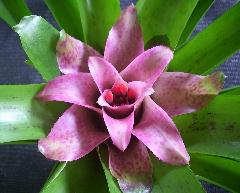
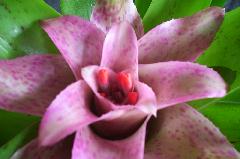
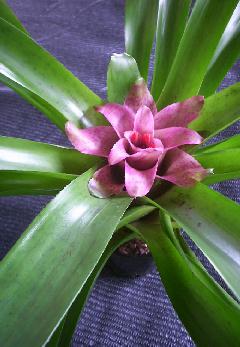
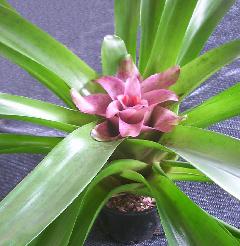
Nidularium ‘Leprosa’ by Derek Butcher.
In January 1999 Charles Dills was asked what a Nidularium ‘Laparosa’ looked like and put the question to Brom-l. This name sounded familiar to me because I had a similar question also from California in 1991 when I was conducting the Question and Answer segment in the Bromeliad Society Journal. Here I had been asked the differences between Nidularium rutilans, N. regelioides, and N. ‘Leprosa’. At that time the only difference I could find between the first two was that in N. rutilans the primary bracts are entire but lightly toothed in N. regelioides. Note that Elton Leme probably will be relegating N. regelioides to synonymy under N. rutilans when his book on Nidularium is published. Nidularium ‘Leprosa’ was a bit harder to find. It was not in “Bromelioideae” in Flora Neotropica (1979) nor was it in Padilla’s “International Check List” (1979). The only reference was in Brian Smith’s Manuscript of Bromeliad Hybrids and Cultivars (1984). Even the hybridist was unknown but the name persists! The parents were given as N. regelioides and N. rosulatum.
Forever the doubting Thomas I wonder whether N. rosulatum was father. This plant is not common in collections and even Lyman B Smith confused it with N. fulgens at one time!
Nidularium ‘Leprosa’ seems to have a limited area of circulation because it is only reported from California and has not been exported to Australia as far as I am aware. Could it be just a selfing of Nidularium regelioides? This is especially true if it does eventuate that this becomes included under Nidularium rutilans. We have certainly found in Australia that spotting on the leaves for N. rutilans can vary widely with the more heavily spotted being favoured. All the N. rutilans I have checked seem to be correctly named so I wonder whether the name of “Leprosa’ should have been given.
I am hoping that this provocative statement will get some reaction so that we can find out what the true N. ‘Leprosa’ is known to all. A photograph would be fantastic.
Nidularium rosulatum / `Leprosa'. 21/02/02. By Gerry Stansfield. Auckland, New Zealand.
Examination of total inflorescence, Floral bracts and including flower and components.
The whole of the inflorescence head that, consists of some 16 floral bracts was cut from the plant and measured 130mm from the cut to the top of the floral bracts. From the base, the first three very small floral bracts ( or perhaps you call these leaves) are greenish with purple spots, one is 55mm long and 34mm wide while the other is larger at 95mm long and 55mm wide. All the other floral bracts are shell pink, and the largest of these measures 115mm long and some 80mm at its widest point. All the floral bracts have a group of flowers at the base with primary and secondary bracts attached to a stem, which is very closely attached to the main stem.
The first small (green) floral bract or leaf, (as you may call them) has two very small immature flowers with two very small primary (is it) bracts and two very small secondary bracts, the primary bracts are much wider and enclose the flowers and secondary bracts at both ends, as shown in the photo's.
The second outside green floral bract or leaf ( see photo) has a group of four flowers all attached to the main stem at a single base as a group. They are not immature but full flowers although are spent at this stage. They are in two groups of two, and each group has two large primary bracts on the outside and two small secondary bracts on either side of the two flowers (see photo). The next floral bract or leaf, is the last of the green ones and has six flowers in groups of two, and again has two outer large primary bracts and two inner or next to the flower secondary bracts (see photo).
The first of the Pink floral bracts has six flowers one of which is in flower (see photo) and we shall now look at the flower, as all other parts are the same as the last bract. The flowers are triangular shaped so as they all fit into the group I believe, with each flower having a small secondary bract attached, from where they are attached at the base of the group I have measured the following.
Typical of all Nidulariums, the flowers do open but remain closed during their life. Flower colour. The petals are a orange/red and are identical in colour to Nid. regelioides and Nid. rutilans.
Total length of flower from base of ovary to tip of petals 45mm lang. Length of ovary chamber 16mm long, width 6mmx6mmx5mm (triangular). Length of sepals (3) 18mm from tap of ovary chamber to tip of sepals, 8mm wide at widest point.
Length of petals (3) 35mm from the top of ovary chamber to the tip of the petals.
Length of stigma 32mm from top of ovary chamber and is well above the pollen stamens. The pollen stamens (6)are attached to the petals (2 per each petal), the pollen anthers are 5mm long and the filament is 7 to 8mm long and is attached to the petal some 12mm from the top of the petals.
The flowers are closed and the stigma protrudes past the anthers by some 4mm.
As we move into the main inflorescence of floral bracts, the first of the larger pink floral outer bracts has 9 flowers in groups of one of 4, one of 3, and one of 2, however this is the only one to have 9 flowers, all the other floral bracts have 8 in groups of 3+3+2.
The group has a large and wide outer primary bract and is boat shaped and wrapped around the flower along with its secondary bract, at both ends and also in the centre (see photo), each flower has one small secondary bract. You can see by the photo(I hope), that each group from the left hand side, the centre, and the two at the right had side, has this large boat shaped bract. These out side bracts are 30mm long and 10mm wide on both side i.e. the boat shape is 20mm wide total, (if you want a drawing of these drawing let me know). The rest of the flowers appear to be in groups of 3,3,2 in each of the floral bracts towards the centre. In the final two small floral bracts in the centre, there is one group of 4 flowers and in the very centre one group of three.
NIDULARIUM ‘LEPROSA’ by Derek Butcher Feb 2002.
For the purists please note that ‘Leprosa’ is the original name given, is anglicised Latin, and treated as a cultivar name it does not change “sex”! It also seems classier than ‘Leprosy’!
10 years ago I was the Conductor of Questions and Answers in the Journal of the Bromeliad Society Inc. and most times I had to think up my own questions but there was at least one ‘real’ one! This was “What do you know about Nidularium leprosa ?” Using Editorial licence this question and answer appeared in JBS 1991 p224 as follows.
“Question. How do you distinguish among Nidularium rutilans, Nid. regelioides, and Nid. Leprosa ?
Answer. Nidularium rutilans and Nid. regelioides are recognised species but Nid. Leprosa was a bit harder to find. The only reference available was Brian Smith’s Manuscript of Bromeliad Hybrids and Cultivars where Nid. Leprosa is listed as a hybrid of Nid. regelioides and Nid. rosulatum. I must point out that Brian gleaned his information from official lists AND nursery catalogues. It is a sad reflection on the aims of our Society when some hybrids occur only in Nursery Catalogues.
I wonder if the plant that caused the question was a clone of the original hybrid or an F2 seedling? If a seedling it would not be Nid. Leprosa but a plant with affinities to either parent. Being a hybrid, identification would be very difficult.
Let us look at the two species. Nidularium rutilans was named in 1885 and Nid. regelioides in 1898. At one time, Nid. rutilans was reduced to synonymy under Nid. regelioides. Now we consider them separate but closely related. The main difference seems to be that the floral bracts are entire (smooth) in Nid. rutilans but serrate (toothed) in Nid. regelioides.“
Since that time Nid. regelioides has been relegated to being a synonym of Nid. rutilans (see Leme 2000) because the serrations on the floral bracts are very minor and this difference did not warrant a separate species. This does not mean that horticulturally they are now treated as a single entity because some forms are more outstanding than others. Are these forms worthy of identification in the Bromeliad Cultivar registry under ICNCP rules?
Let us now look at Nidularium ‘Leprosa’ Is it a hybrid of Nid. regelioides and Nid. rosulata? If so why is so spotted? Is it just an extra spotted form of Nid. regelioides (Now Nid. rutilans)? What do we know about the alleged hybrid? Nothing much! But we do know that the Manuscript of Bromeliad Hybrids and Cultivars by Brian Smith 1984 was compiled from Nurserymen’s lists around the USA in this period. From what I can discover, the name of the Nursery was not given which in hindsight is a pity. However, we must remember the furore caused by Grande, a publication under the auspices of the Florida Council of Bromeliad Societies, in 1978 in daring to suggest that hybridists practices could be improved. Did Nid. ‘Leprosa’ originate in California or Florida? I tend to believe Florida because in Smith’s Manuscript (1984) mention is made of other unregistered hybrids originating in Florida using similar Nidularium species.
Was the Nid. rosulatum used correctly identified? Certainly the Nid. rosulatum pictured in Baensch (1994), p132 with its white flowers (instead of blue) is incorrectly identified and I would suggest that many of Baensch’s plants would have come from Florida. This species is rare and as Leme (2000) points out, only one clone exists in cultivation. The chance of a correctly named Nid. rosulatum being the pollen parent is not high.
Nid. ‘Leprosa’ has red flowers which links closely to the Red flowered Complex of Leme and thus has closer ties to Nid. rutilans. It is of sufficient horticultural note to retain this name even though its hybrid status is in doubt. Thanks to the work of Gerry Stansfield in NZ we are now able to define Nid. ‘Leprosa’. I will not bore you with the detail Gerry has gone into but on comparing his findings with the descriptions of both Nid. rosulatum and Nid. rutilans in Leme (2000) I can find no hint of the involvement of Nid. rosulatum. When Gerry showed that Nid. ‘Leprosa’ had tripinnate flowers which links with Nid. rutilans rather than the bipinnate Nid. rosulatum I was convinced this plant is not a hybrid but a very good cultivar of a species. One other interesting fact is that the fascicles (the side bunches of flowers that appear inside the colourful primary bracts of Nidularium) have on the average 7 – 9 flowers whereas they are quoted as 4 – 6 for Nid. rutilans.
The name ‘Leprosa’ will live on in the Bromeliad Cultivar Registry where I will be making suitable amendments including photographs to help in identification. Illegitimate names such as ‘Spotty’ or Nid. regelioides var. rosulatum are not acceptable.
Reference: Leme, E.M.C., 2000. Nidularium – Bromeliads of the Atlantic Forest, GMT Editores Ltda., Rio de Janeiro.
Updated 16/03/17






